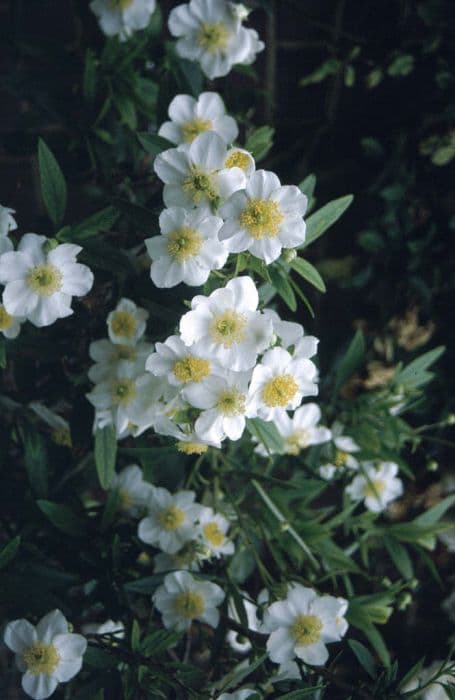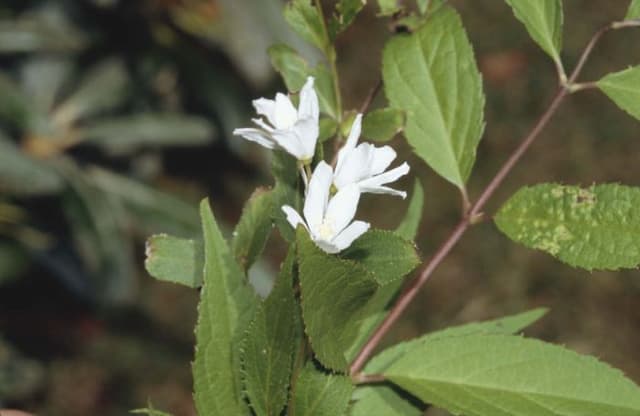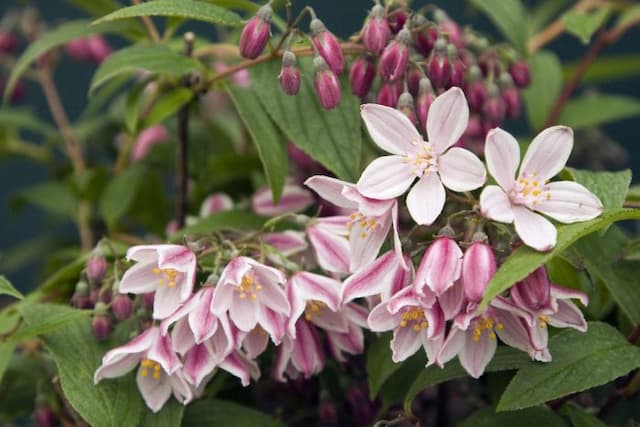Bush anemone Carpenteria californica

ABOUT
Carpenteria californica, often known as the bush anemone, is a charming flowering plant native to California. This plant captivates with its lush, dark green leaves that are narrow and glossy, providing a year-round verdant backdrop to its striking blooms. During the flowering season, the bush anemone comes alive with large, white flowers that resemble those of the anemone. These fragrant blossoms have a brushed-on look of subtle yellow at their center, where a cluster of bright, golden stamen rests. The bush anemone's flowers are its most prominent feature, drawing the eye and often serving as a focal point in gardens. The overall form of this plant is elegantly rounded, presenting a dense foliage that gives it a bushy, compact appearance. Despite its delicate look, the bush anemone is known for its resilience and ability to thrive with minimal care once established, making it a favored addition to water-wise and native gardens. Its beauty and low-maintenance nature render it a charismatic choice for landscapers and garden enthusiasts alike.
About this plant
 Names
NamesFamily
Hydrangeaceae.
Synonyms
California Carpenteria, Tree Anemone, Bush Anemone, Carpenteria.
Common names
Carpenteria californica
 Toxicity
ToxicityTo humans
Carpenteria, commonly known as the Bush Anemone, is not widely recognized for its toxicity to humans. There is limited information available regarding its poisonous properties. As with many plants, it is generally advised to avoid ingestion, as it may cause gastrointestinal discomfort or other negative reactions in sensitive individuals. However, there are no specific symptoms of poisoning commonly associated with Bush Anemone, indicating that it is not typically considered toxic to humans.
To pets
Bush Anemone is not commonly known to be toxic to pets. Information on the specific effects of this plant on animals is scarce, suggesting that it is not associated with severe toxicity. Nevertheless, pet owners should always be cautious and prevent pets from ingesting plants as they can occasionally cause mild gastrointestinal upset or other adverse reactions, regardless of recognized toxicity.
 Characteristics
CharacteristicsLife cycle
Perennials
Foliage type
Evergreen
Color of leaves
Green
Flower color
White
Height
6 feet (1.8 meters)
Spread
4 feet (1.2 meters)
Plant type
Shrub
Hardiness zones
8
Native area
California
Benefits
 General Benefits
General Benefits- Aesthetic Appeal: Carpenteria californica, commonly known as the bush anemone, adds beauty to gardens with its shiny green foliage and large, fragrant, white flowers that bloom in late spring and early summer.
- Attracts Pollinators: The bush anemone is a nectar-rich plant that attracts bees, butterflies, and other beneficial pollinators, supporting local ecosystems.
- Drought Tolerance: Once established, the bush anemone is drought-tolerant, making it suitable for xeriscaping and water-wise gardens in areas with water restrictions.
- Low Maintenance: The bush anemone typically requires minimal maintenance, as it does not need regular pruning and is relatively free from pests and diseases.
- Native Plant Advantages: As a California native plant, the bush anemone is well-adapted to local climates and soils, which can result in fewer gardening challenges and support for native biodiversity.
- Privacy Screening: When planted in groups or rows, bush anemones can provide a moderate screen or hedge, offering privacy and reducing noise for garden spaces.
- Seasonal Interest: The plant provides year-round interest with evergreen foliage, flowers in spring and early summer, and potential for ornamental seed pods later in the season.
 Medical Properties
Medical PropertiesThis plant is not used for medical purposes.
 Air-purifying Qualities
Air-purifying QualitiesThis plant is not specifically known for air purifying qualities.
 Other Uses
Other Uses- Carpenteria californica, also known as Bush Anemone, can be used as an informal hedge in garden landscapes, providing a backdrop of glossy green leaves and white flowers.
- The plant's dense foliage provides excellent shelter for birds and small wildlife in garden settings.
- The fragrant flowers can be cut and used in floral arrangements, bringing the beauty and scent of the garden indoors.
- Bush Anemone can be used in coastal gardens as it tolerates seaside conditions better than many other plants.
- The wood of Bush Anemone can be used in small woodworking projects, as it is sturdy and fine-grained.
- This plant can be grown in larger containers on patios or balcony gardens, where space is limited but height and structure are needed.
- Bush Anemone can act as a natural screen or privacy barrier when planted in a row or cluster.
- The plant can be used to prevent soil erosion on slopes or in areas with loose soil due to its root system.
- In larger landscapes, it can be used as a 'filler' plant to create a full garden design without overwhelming other plants.
- Its drought tolerance makes it a suitable choice for xeriscaping, which requires plants with low water needs.
Interesting Facts
 Feng Shui
Feng ShuiThe Carpenteria californica is not used in Feng Shui practice.
 Zodiac Sign Compitability
Zodiac Sign CompitabilityThe Carpenteria californica is not used in astrology practice.
 Plant Symbolism
Plant Symbolism- Purity: With its clean white flowers, the Carpenteria californica, commonly known as California bush anemone, often symbolizes purity and innocence.
- Peace: The gentle appearance of the California bush anemone's blooms can represent calmness and serenity, making it a symbol of peace.
- Spirituality: Due to its ethereal white flowers that seem to float above the foliage, it is sometimes associated with spiritual themes and the search for higher truth.
- Nature's Delicacy: The delicate nature of California bush anemone blooms can symbolize the fine and often fragile beauty of the natural world.
- Simplicity: Reflecting the plant's simple yet elegant form, it can stand for simplicity and the beauty that can be found in a minimalist approach to life.
 Water
WaterBush anemone should be watered deeply but infrequently to mimic its natural habitat conditions. In the growing season, water every one to two weeks, applying about 1 to 1.5 gallons per watering for a medium-sized plant, depending on soil drainage and weather conditions. Ensure the top few inches of soil dry out between waterings to prevent root rot. During the dormant season, reduce watering but do not let the plant dry out completely, aiming for once every three to four weeks with slightly less water.
 Light
LightBush anemone thrives in full sun to partial shade. It should be planted in a spot where it can receive at least six hours of sunlight per day, but it can also benefit from light afternoon shade in hotter climates. Avoid deep shade as it can lead to poor flowering and weak, leggy growth.
 Temperature
TemperatureThe bush anemone prefers mild climates and is hardy in USDA zones 8 through 10. It can tolerate temperatures down to 10 degrees Fahrenheit but may suffer damage at this extreme. The ideal temperature range for optimal growth is between 60 and 75 degrees Fahrenheit, with occasional dips and rises outside of this range being tolerated as long as they are not prolonged.
 Pruning
PruningPrune bush anemone to maintain shape and encourage bushier growth, typically once a year after the flowering season ends. Cut back spent flower stems and remove any dead or crossing branches to improve air circulation. The best time for pruning is late winter to early spring before new growth begins. This timing will minimize the risk of cutting back new flower buds and promote vigorous growth in the coming season.
 Cleaning
CleaningAs needed
 Soil
SoilBush Anemone thrives in well-draining soil with a pH of 6.0 to 7.5. A mix of two parts loam, one part sand or perlite, and one part compost or peat moss is ideal for promoting healthy growth and drainage.
 Repotting
RepottingBush Anemone does not require frequent repotting; it should be repotted every 2 to 3 years or if it outgrows its current container, ensuring minimal root disturbance.
 Humidity & Misting
Humidity & MistingBush Anemone prefers moderate humidity levels but is quite adaptable and can tolerate the humid conditions typical of many inhabited indoor and outdoor spaces.
 Suitable locations
Suitable locationsIndoor
Place Bush Anemone near a sunny window and avoid overwatering.
Outdoor
Plant in well-draining soil with partial to full sun exposure.
Hardiness zone
8-10 USDA
 Life cycle
Life cycleCarpenteria californica, commonly known as the Bush Anemone, begins its life as a seed, often requiring stratification—a period of cold to break dormancy. Upon germination, which may be sporadic, the seedling develops a root system and shoots, eventually forming a small shrub. As it matures, the plant forms lush, evergreen foliage and, in late spring or early summer, produces showy white flowers with yellow centers, which are attractive to pollinators. After pollination, the flowers develop into fruit containing seeds, which can disperse to begin a new cycle. The Bush Anemone can live for several years, during which it will bloom annually, with each cycle contributing to the growth and development of the shrub. With proper care and favorable conditions, Carpenteria californica can reach mature sizes of up to 8 feet tall and wide, existing as a perennial fixture in its native or cultivated landscape.
 Propogation
PropogationPropogation time
Spring to Summer
The most popular method of propagating the Bush Anemone (Carpenteria californica) is by semi-hardwood cuttings. This technique is typically performed in the late summer. First, select a healthy, semi-hardwood stem that has matured from the current season's growth and cut a length of about 4 to 6 inches (approximately 10 to 15 centimeters). The cutting should be made just below a leaf node, and the lower leaves should be removed. The base of the cutting is then treated with a rooting hormone to encourage root growth. It is then placed in a well-draining rooting medium, such as a mix of perlite and peat, and kept moist but not waterlogged. During this process, the cuttings should be kept in a warm environment with indirect light until roots have established, after which they can be transplanted into pots or directly into the garden.







![Hydrangea [Strong Annabelle]](/_next/image?url=https%3A%2F%2Fplants-admin.emdemapps.com%2Fimages%2Fplants%2F%2Fimages%2F604b54db37d34.png&w=640&q=75)

